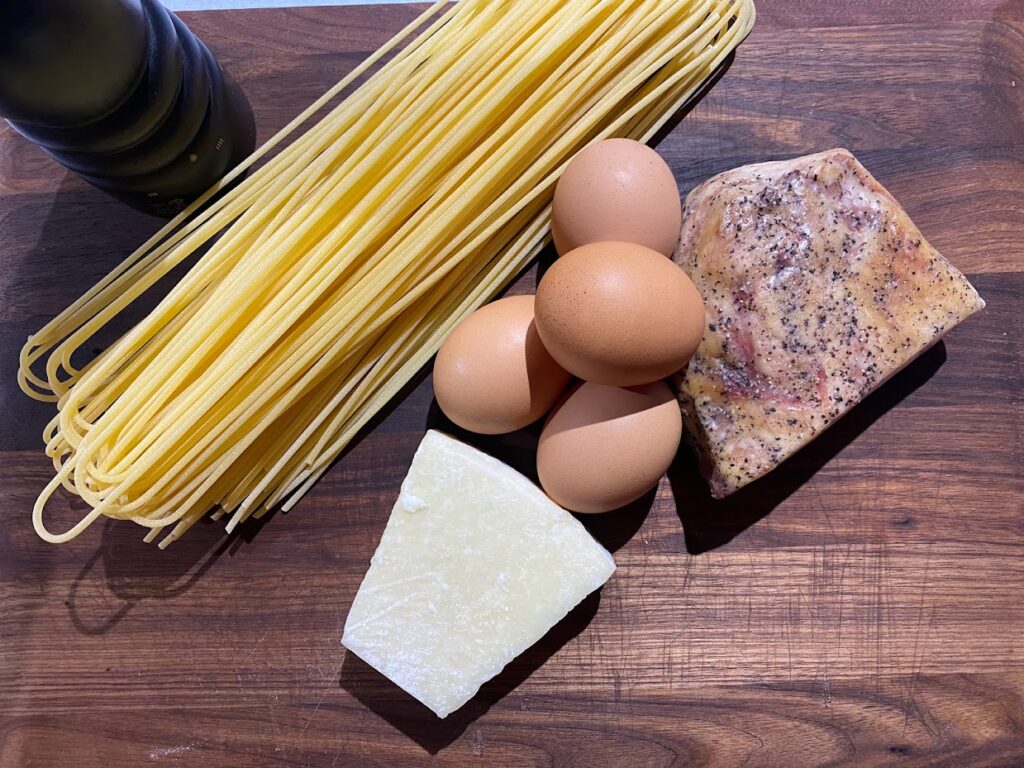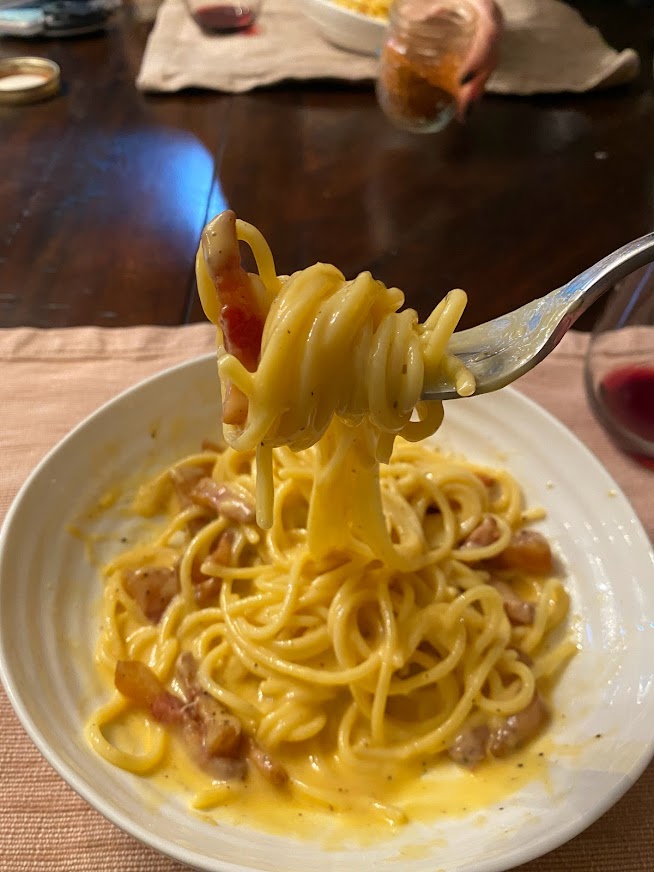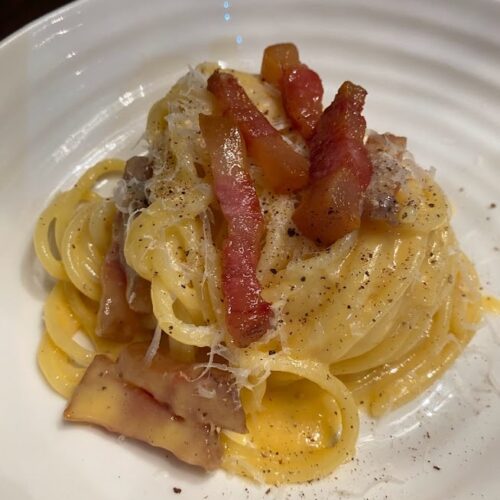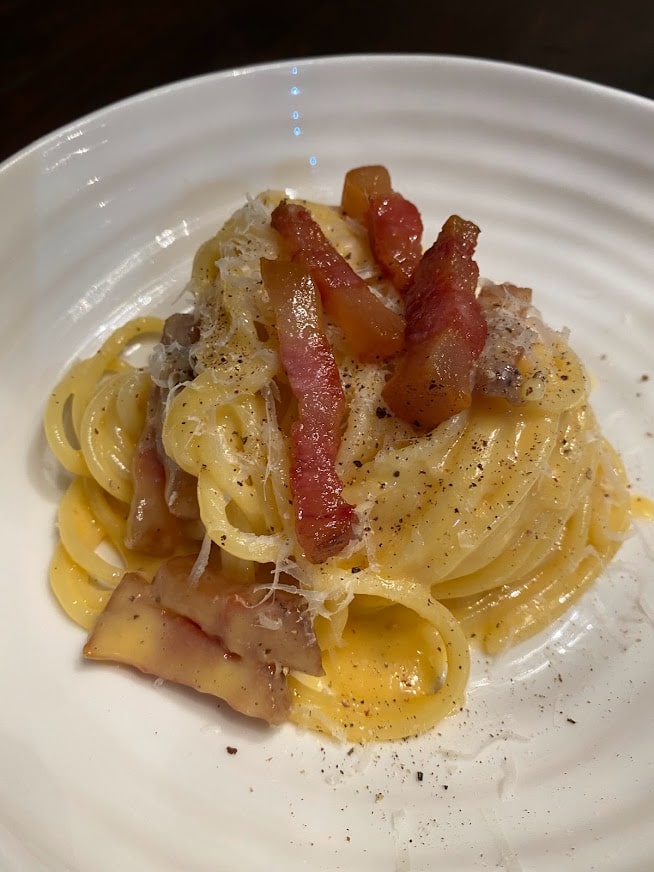Traditional Pasta Carbonara
Pasta carbonara is one of the four famous Roman pasta dishes; Carbonara, Alla Gricia, Amatriciana, and Cacio e Pepe. Each of the four dishes uses an assortment of the same few ingredients. Each of them is fairly simple and straightforward and if done properly creates magic that is greater than the sum of its parts.
If you are posting your food creations to social media, Spaghetti Carbonara is one of those dishes that can make Italians or carbonara connoisseurs cringe if made wrong, and they will let you know it.
Carbonara is a dish that is very easy to make, but also very easy to mess up. Making the dish properly will have the Carbonara police praise you and leave them with nothing bad to say about the dish.
Here are some rules we are going to abide by:
- We are not going to be adding garlic!
- We are not going to be using cream!
- We are not going to be adding parsley!
- There are no peas in carbonara!
The two most important factors to make a great Carbonara are the ingredients and the technique.
To make delicious Carbonara let’s start with the ingredients. Obviously, you want to use high-quality ingredients because that will make your dish turn out better, but you also need to use the proper ingredients to make a traditional Carbonara.
Carbonara Ingredients

Carbonara is simple and only needs a few ingredients to make it properly.
Pasta: Pretty hard to make the dish without this. The reason I added pasta to the ingredient list is that you need to use the right kind of pasta! The best pasta to use for carbonara is dried semolina flour pasta. I prefer to use spaghetti, bucatini, or rigatoni shape. One of the biggest mistakes you can make in creating this dish is using egg noodle pasta instead of regular old dried pasta. If you use egg noodles the pasta dish will turn out too eggy. Another mistake is using fresh pasta. If you are using fresh pasta, you will lose the bite you can only get from al dente pasta.
Egg Yolk: Not all egg yolks are created equal. I’ve made Carbonara on dozens of occasions and have used different eggs in the process. You want to use fresh, brightly colored egg yolks that appear more orange than yellow. Using brightly colored eggs will completely transform the dish by giving it a beautiful appearance when plated. Yellow yolks get lost in the pecorino and the end result will be more of a white carbonara vs a vibrant yellow.
Guanciale: This is the only acceptable meat to use! Not really though. You can still make a delicious Carbonara with bacon or pancetta and it will turn out great, but the carbonara police will notice it for sure. Guanciale is the traditional meat used in the dish, it is a dry cured pork cheek that is hung to dry that is fatty like bacon but is extra rich, and salty, and transforms the taste. Guanciale > Pancetta > Bacon.
Pecorino Cheese: Pecorino Romano is a sharp sheep’s milk cheese that has a very distinct flavor. It has a hard texture similar to Parmigiano Reggiano, which can be used as a substitute for pecorino, but again, will result in a non-traditional and inferior carbonara. There are many recipes out there that use both kinds of cheese.
Pepper: Black pepper is such a simple ingredient but it is needed to cut down the richness and leave that beautiful and subtle pepper taste on your tongue.
Don’t ruin your Carbonara!
Even with the perfect ingredients if you do not combine them properly or use the proper technique to cook the dish you may end up with scrambled egg pasta (I have done this before and it is not enjoyable) or a dry pasta dish that lacks depth instead of a rich, creamy pasta that will impress.

The recipe I will share can feed 4 people, but I typically make it and share it between 3 because it’s just too damn good.
So without further ado, the recipe and techniques to make a creamy carbonara without cream!
Traditional pasta Carbonara Recipe
Ingredients
- 1.5 cup Pecorino Romano
- 6 Egg yolks
- 8oz Guanciale
- 450g Spaghetti
- Salt
- Pepper
- Start boiling your water in a wide low pot and add salt, less than you would usually add when making pasta. The low pot will allow you to use less water, producing starchier water for later.
- Cut your guanciale into 1/2inch cubes and place them into a pan and start cooking on medium-high heat. Once the guanciale is crisp and golden brown in color, remove the meat from the pan. Leave the rendered fat in the pan, and turn off the heat. Roughly 10 mins.
- While your guanciale cooks and once your water is boiling add the pasta of your choice. My favorite is spaghetti or bucatini. Cook for one minute less than the instructions listed on the box. Drain and reserve 1 cup of pasta water.
- While the pasta cooks, in a bowl, add your egg yolks and finely grated pecorino romano and whisk together until it gets the consistency of oatmeal (I need a better way to describe this maybe). Crank in a good amount of freshly ground pepper and set aside.
- This is where the magic happens.
- Once the pasta is cooked, add the drained pasta directly into the pan that was used for cooking the guanciale. Turn on the heat to medium-high and add ½ cup of pasta water. Mix the pasta vigorously until the pasta water and rendered fat from the guanciale emulsify and the pasta becomes al dente.
- Pour the pasta and sauce into a large bowl. Start to slowly add the egg and pecorino mixture while stirring the pasta constantly to mix and bring the sauce to a creamy consistency. Mix in ¾ of the guanciale. Taste for salt now before plating. Depending on the guanciale, pecorino, and how much salt you added to the pasta water you may not need to add any.
- Plate your beautiful spaghetti carbonara. Top the bowls with freshly grated pecorino, cracked pepper, and the remaining golden guanciale (do it in this order).
Congratulations, you just made the best traditional pasta Carbonara.
Buon Appetito.

Traditional Pasta Carbonara
Ingredients
- 1.5 cups Pecorino Romano Finely grated
- 6 Egg Yolks
- 8 Oz Guanciale Cubed
- Pepper Freshly cracked
- Salt To taste
- 450 g Spaghetti
Instructions
Cook the Pasta
- Boil water and add salt
- Cook the pasta for 1 minute less than recommended
- Do not discard pasta water
Prepare the guanciale
- Cut the guanciale into ½” lardons (strips)
- Saute in a saucepan over medium heat until golden brown and crispy
- Remove guanciale from pan
- Leave the rendered fat in the saucepan
- Remove the saucepan from the heat
Prepare the egg and cheese mixture
- Whisk together the egg yolks and pecorino romano
- Add freshly cracked pepper, and whisk
- You want a thick consistancy like oatmeal.
Start the Sauce
- Add the undercooked pasta to the saucepan with the rendered fat
- Place the saucepan over medium-high heat
- Add ½ cup of starchy pasta water
- Mix the pasta in the saucepan vigorously until the starchy water and rendered fat emulsify
- Continue adding small amounts of the starchy pasta water as needed to cook the pasta al dente (the final product should not have excess water in the saucepan)
Finish the Pasta
- Transfer the pasta to a large bowl
- Stir the pasta and slowly add in the egg and pecorino romano mixture, make sure to stir constantly
- Stir in ¾ of the guanciale
- Taste for salt and mix in additional if required
Plate the pasta
- Portion pasta into bowls
- Top with freshly grated pecorino romano
- Top with freshly ground black pepper
- Top with remaining ¼ guanciale
Notes
- Boil the pasta with less water than usual to concentrate the starches, improving the flavor and texture of the sauce.
- Cook the pasta in boiling water for 1 minute less than recommended
- Use wheat flour or semolina pasta, not egg noodles
- Use guanciale instead of bacon or pancetta for its improved flavor and fat rendering
- Do not add too much pasta water at once when emulsifying the pasta and rendered fat in the saucepan because the final product should not have excess
- Ensure you use enough pecorino romano in the egg mixture such that the mixture is clumpy
- Be sure to use a separate large bowl when combining the pasta with the egg and pecorino romano mixture otherwise you’ll end up with scrambled eggs
- Stir the pasta fast but pour the egg and pecorino mixture slowly because stirring too slowly and pouring the mixture too quickly will result in failed emulsification

Pingback: Pasta All'Amatriciana - Simply Sautéed
The best Carbonara from the Carbonara King
This is the bomb technique after failed attempts perfect every time
This turned out amazing!! I was never able to do carbonara right until following this recipe and tips.
Pingback: Pasta Alla Gricia - Simply Sautéed
Pingback: Pasta Alla Puttanesca - Simply Sautéed
Pingback: Linguine Alle Vongole: Pasta with Fresh Clams - Simply Sautéed